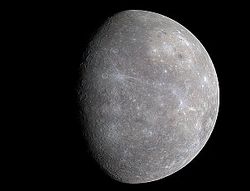Difference between revisions of "Mercury"
From FenWiki
(added new section "External Links", and listed a relevant link in it) |
|||
| (3 intermediate revisions by the same user not shown) | |||
| Line 1: | Line 1: | ||
| − | |||
| − | |||
{{Planetbox | {{Planetbox | ||
|name=Mercury | |name=Mercury | ||
| Line 11: | Line 9: | ||
|temp=179°C (354.2°F) | |temp=179°C (354.2°F) | ||
|atmosphere=none | |atmosphere=none | ||
| − | |waterice=0% | + | |waterice=~0% |
| − | |population= | + | |population= |
| − | |political= | + | |political= |
| − | |government= | + | |government=Corporate (mining companies based in the 'Danelaw) |
| − | |capital= | + | |capital= |
}} | }} | ||
| − | '''Mercury''', [[Venus]], [[Earth]], and [[Mars]] are terrestrial (rocky) planets. Among these, Mercury is an extreme: the smallest, the densest (after correcting for self-compression), the one with the oldest surface, the one with the largest daily variations in surface temperature | + | '''Mercury''', [[Venus]], [[Earth]], and [[Mars]] are terrestrial (rocky) planets. Among these, Mercury is an extreme: the smallest, the densest (after correcting for self-compression), the one with the oldest surface, and the one with the largest daily variations in surface temperature. |
| − | + | ''(Text excerpted from NASA [http://messenger.jhuapl.edu/why_mercury/index.html MESSENGER Probe website])'' | |
| − | + | ||
| − | ''(Text | + | |
| + | The [[Soviet Air Force]] research vessel ''[[Ptichka]]'' was the first ship to land on Mercury. The planet has since become a source of easily-obtained metals, many in purer forms than the metals available in the [[Main Belt]] because they have gone through multiple melt/freeze cycles as Mercury rotates. | ||
== Known Places on or around Mercury == | == Known Places on or around Mercury == | ||
| Line 29: | Line 26: | ||
* various mining stations | * various mining stations | ||
| − | [ | + | == External Links == |
| − | + | ;[http://apod.nasa.gov/apod/ap130612.html All of Mercury] | |
| − | + | :Astronomy Picture of the Day, 2013 June 12 - a false-color animation of an orbit around Mercury. | |
{{places}} | {{places}} | ||
| + | [[Category:Mercury| ]] | ||
Latest revision as of 00:59, 28 March 2014
| Mercury | |
 | |
| Planetary characteristics | |
|---|---|
| Orbit | 57,910,000 |
| Diameter | 4,880 km (equatorial) |
| Surface Gravity | 0.38G |
| Year | 87.96 days |
| Day | 58.64 days |
| Mean Temperature | 179°C (354.2°F) |
| Atmosphere | none |
| Water/Ice Index | ~0% |
| Government | Corporate (mining companies based in the 'Danelaw) |
Mercury, Venus, Earth, and Mars are terrestrial (rocky) planets. Among these, Mercury is an extreme: the smallest, the densest (after correcting for self-compression), the one with the oldest surface, and the one with the largest daily variations in surface temperature.
(Text excerpted from NASA MESSENGER Probe website)
The Soviet Air Force research vessel Ptichka was the first ship to land on Mercury. The planet has since become a source of easily-obtained metals, many in purer forms than the metals available in the Main Belt because they have gone through multiple melt/freeze cycles as Mercury rotates.
Known Places on or around Mercury
- various mining stations
External Links
- All of Mercury
- Astronomy Picture of the Day, 2013 June 12 - a false-color animation of an orbit around Mercury.